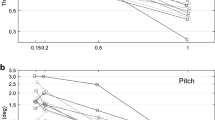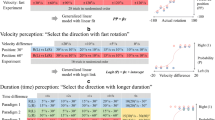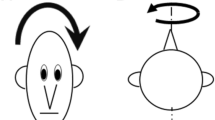Abstract
This effort seeks to further assess human perception of self-motion by quantifying and comparing earth-vertical rotational vestibular perceptual thresholds about the yaw, roll, and pitch axes. Early seminal works (Benson Aviat Space Environ Med 60:205–213, 1989) quantified thresholds for yaw, roll, and pitch rotations, using single-cycle sinusoids in angular acceleration with a frequency of 0.3 Hz (3.33 s motion duration) and found yaw thresholds to be significantly lower than roll and pitch thresholds (1.58–1.20 deg/s vs. 2.07 deg/s and 2.04 deg/s, respectively). Our current effort uses modern methods and definitions to reassess if rotational thresholds differ between these three axes of rotation in ten human subjects at 0.3 Hz and additionally across a range of frequencies: 0.1 Hz, 0.3 Hz, and 0.5 Hz. In contrast to the established findings of Benson et al., no statistically significant differences were found between the three rotational axes at 0.3 Hz. Further, no statistically significant differences were found at any of these frequencies. Instead, a consistent pattern was found for yaw, pitch, and roll of increasing thresholds with decreasing rotational frequency, consistent with the brain employing high-pass filter mechanisms for decision-making. We also fill a gap in the literature by extending the quantification of pitch rotation thresholds to 0.1 Hz. Finally, we assessed inter-individual trends between these three frequencies and across all three axes of rotation. In thoroughly considering methodological and other differences between the current and previous studies, we conclude yaw rotation thresholds do not differ from those in roll or pitch.






Similar content being viewed by others
Data availability
Beyond the data included in this published article, additional datasets generated during and/or analyzed during the current study are available from the corresponding author on reasonable request.
References
Agrawal Y, Bremova T, Kremmyda O, Strupp M, MacNeilage PR (2013) Clinical testing of otolith function: perceptual thresholds and myogenic potentials. J Assoc Res Otolaryngol 14(6):905–915. https://doi.org/10.1007/s10162-013-0416-x
Allred, A. R. (2021). Vestibular Perceptual Thresholds for Angular Rotation about the Yaw, Roll, and Pitch Axes [University of Colorado Boulder]. https://scholar.colorado.edu/concern/graduate_thesis_or_dissertations/x920fz25n
Angelaki DE, Cullen KE (2008) Vestibular system: the many facets of a multimodal sense. Annu Rev Neurosci 31(1):125–150. https://doi.org/10.1146/annurev.neuro.31.060407.125555
Benson AJ, Hutt EC, Brown SF (1989) Thresholds for the perception of whole body angular movement about a vertical axis. Aviat Space Environ Med 60(3):205–213
Bermúdez Rey MC, Clark TK, Wang W, Leeder T, Bian Y, Merfeld DM (2016) Vestibular perceptual thresholds increase above the age of 40. Front Neurol. https://doi.org/10.3389/fneur.2016.00162
Blanks RH, Estes MS, Markham CH (1975) Physiologic characteristics of vestibular first-order canal neurons in the cat. II. Response to constant angular acceleration. J Neurophysiol 38(5):1250–1268. https://doi.org/10.1152/jn.1975.38.5.1250
Bremova T, Caushaj A, Ertl M, Strobl R, Böttcher N, Strupp M, MacNeilage PR (2016) Comparison of linear motion perception thresholds in vestibular migraine and Menière’s disease. Eur Arch Otorhinolaryngol 273(10):2931–2939. https://doi.org/10.1007/s00405-015-3835-y
Chaudhuri SE, Merfeld DM (2013) Signal detection theory and vestibular perception: III. Estimating unbiased fit parameters for psychometric functions. Exp Brain Res 225(1):133–146. https://doi.org/10.1007/s00221-012-3354-7
Clark TK, Merfeld DM (2021) Statistical approaches to identifying lapses in psychometric response data. Psychon Bull Rev 28(5):1433–1457. https://doi.org/10.3758/s13423-021-01876-2
Clark TK, Yi Y, Galvan-Garza RC, Bermúdez Rey MC, Merfeld DM (2018) When uncertain, does human self-motion decision-making fully utilize complete information? J Neurophysiol 119(4):1485–1496. https://doi.org/10.1152/jn.00680.2017
Cremer P (1998) Semicircular canal plane head impulses detect absent function of individual semicircular canals. Brain 121(4):699–716. https://doi.org/10.1093/brain/121.4.699
Gabriel GA, Harris LR, Gnanasegaram JJ, Cushing SL, Gordon KA, Haycock BC, Pichora-Fuller MK, Campos JL (2021) Vestibular perceptual thresholds in older adults with and without age-related hearing loss. Ear Hear. https://doi.org/10.1097/AUD.0000000000001118
Gibb R, Ercoline B, Scharff L (2011) Spatial disorientation: decades of pilot fatalities. Aviat Space Environ Med 82(7):717–724. https://doi.org/10.3357/ASEM.3048.2011
Goldberg JM, Fernandez C (1975) Vestibular mechanisms. Annu Rev Physiol 37:129–62. https://doi.org/10.1146/annurev.ph.37.030175.001021
Grabherr L, Nicoucar K, Mast FW, Merfeld DM (2008) Vestibular thresholds for yaw rotation about an earth-vertical axis as a function of frequency. Exp Brain Res 186(4):677–681. https://doi.org/10.1007/s00221-008-1350-8
Heinle MTE, & Ercoline MWR (2003). Spatial disorientation: causes, consequences and countermeasures for the USAF. 8.
Hosman R, Stassen H (1999) Pilot’s perception in the control of aircraft motions. Control Eng Pract 7(11):1421–1428. https://doi.org/10.1016/S0967-0661(99)00111-2
Karmali F, Chaudhuri SE, Yi Y, Merfeld DM (2016) Determining thresholds using adaptive procedures and psychometric fits: evaluating efficiency using theory, simulations, and human experiments. Exp Brain Res 234(3):773–789
Karmali F, Bermúdez Rey MC, Clark TK, Wang W, Merfeld DM (2017) Multivariate analyses of balance test performance, vestibular thresholds, and age. Front Neurol 8:578. https://doi.org/10.3389/fneur.2017.00578
King S, Priesol AJ, Davidi SE, Merfeld DM, Ehtemam F, Lewis RF (2019) Self-motion perception is sensitized in vestibular migraine: pathophysiologic and clinical implications. Sci Rep 9(1):14323. https://doi.org/10.1038/s41598-019-50803-y
Kingma H (2005) Thresholds for perception of direction of linear acceleration as a possible evaluation of the otolith function. BMC Ear Nose Throat Disord 5(1):5. https://doi.org/10.1186/1472-6815-5-5
Lewis RF, Priesol AJ, Nicoucar K, Lim K, Merfeld DM (2011a) Abnormal motion perception in vestibular migraine: motion perception in vestibular migraine. Laryngoscope 121(5):1124–1125. https://doi.org/10.1002/lary.21723
Lewis RF, Priesol AJ, Nicoucar K, Lim K, Merfeld DM (2011b) Dynamic tilt thresholds are reduced in vestibular migraine. J Vestib Res 21(6):323–330. https://doi.org/10.3233/VES-2011-0422
Lim K, Karmali F, Nicoucar K, Merfeld DM (2017) Perceptual precision of passive body tilt is consistent with statistically optimal cue integration. J Neurophysiol 117(5):2037–2052. https://doi.org/10.1152/jn.00073.2016
Merfeld DM (2011) Signal detection theory and vestibular thresholds: I. Basic theory and practical considerations. Exp Brain Res 210(3):389–405. https://doi.org/10.1007/s00221-011-2557-7
Merfeld DM, Clark TK, Lu YM, Karmali F (2016) Dynamics of individual perceptual decisions. J Neurophysiol 115(1):39–59. https://doi.org/10.1152/jn.00225.2015
Nouri S, Karmali F (2018) Variability in the vestibulo-ocular reflex and vestibular perception. Neuroscience 393:350–365. https://doi.org/10.1016/j.neuroscience.2018.08.025
Poisson RJ, Miller ME (2014) Spatial disorientation mishap trends in the U.S. Air force 1993–2013. Aviat Space Environ Med 85(9):919–924. https://doi.org/10.3357/ASEM.3971.2014
Priesol AJ, Valko Y, Merfeld DM, Lewis RF (2014) Motion perception in patients with idiopathic bilateral vestibular hypofunction. Otolaryngol Head Neck Surg 150(6):1040–1042. https://doi.org/10.1177/0194599814526557
Robinson DA (1982) The use of matrices in analyzing the three-dimensional behavior of the vestibulo-ocular reflex. Biol Cybern 46(1):53–66. https://doi.org/10.1007/BF00335351
Rosenberg MJ, Galvan-Garza RC, Clark TK, Sherwood DP, Young LR, Karmali F (2018) Human manual control precision depends on vestibular sensory precision and gravitational magnitude. J Neurophysiol 120(6):3187–3197. https://doi.org/10.1152/jn.00565.2018
Suri K, Clark TK (2020) Human vestibular perceptual thresholds for pitch tilt are slightly worse than for roll tilt across a range of frequencies. Exp Brain Res 238(6):1499–1509. https://doi.org/10.1007/s00221-020-05830-x
Treutwein B (1995) Adaptive psychophysical procedures. Vision Res 35(17):2503–2522. https://doi.org/10.1016/0042-6989(95)00016-X
Valko Y, Lewis RF, Priesol AJ, Merfeld DM (2012) Vestibular labyrinth contributions to human whole-body motion discrimination. J Neurosci 32(39):13537–13542. https://doi.org/10.1523/JNEUROSCI.2157-12.2012
van Erp JBF, Groen EL, Bos JE, van Veen HAHC (2006) A tactile cockpit instrument supports the control of self-motion during spatial disorientation. Hum Factors 48(2):219–228. https://doi.org/10.1518/001872006777724435
Wagner AR, Kobel MJ, Merfeld DM (2021) Impact of canal-otolith integration on postural control. Front Integr Neurosci 15:773008. https://doi.org/10.3389/fnint.2021.773008
Wagner AR, Kobel MJ, Merfeld DM (2022) Impacts of rotation axis and frequency on vestibular perceptual thresholds. Multisens Res 35(3):259–287. https://doi.org/10.1163/22134808-bja10069
Yi Y, Wang W, Merfeld DM (2019) A quantitative confidence signal detection model: 2. confidence analysis. J Neurophysiol 122(3):904–921. https://doi.org/10.1152/jn.00400.2016
Acknowledgements
Secondary experiments were performed by Kathrine Bretl, Carson Brumley, Jordan Lerner, Brian Clayton, Nicholas Dembiczak, and Hunter Daboll.
Funding
This work was supported by a NASA Space Technology Graduate Research Opportunities Award.
Author information
Authors and Affiliations
Corresponding author
Ethics declarations
Conflict of interest
The authors declare that they have no conflict of interest.
Ethical approval
The studies involving human participants were reviewed and approved by The Institutional Review Board at the University of Colorado Boulder. The subjects/participants provided their written informed consent to participate in this study.
Additional information
Communicated by Bill J Yates.
Publisher's Note
Springer Nature remains neutral with regard to jurisdictional claims in published maps and institutional affiliations.
Supplementary Information
The opinions and conclusions presented in this paper are those of the authors and do not necessarily reflect the views of the sponsoring organization.
Appendices
Appendix
Examining sampling precision between studies
The testing methods of these two studies (ours and Benson et al.’s) vary in measurement precision when estimating underlying thresholds. This study collected responses using a semi-adaptive staircase with 100 trials whereas Benson et al.’s study collected responses using an adaptive staircase based on a Wald sequential probability test with 50 trials. In general, performing more trials yield a more precise threshold estimate; however, more responsively adapting the stimuli magnitudes can enhance efficiency (Karmali et al. 2016). To quantify this tradeoff, we again performed simulations: now with an underlying 1 – σ threshold ranging from between 1 and 4 deg/s to broadly capture the range of individuals’ rotational thresholds at 0.3 Hz. Figure 7 reveals that Benson et al.’s sampling procedure has relatively worse precision (in terms of a higher coefficient of variance in fitted threshold) than this study’s sampling method, across a broad range (1–4 deg/s) of underlying subject 1 – σ thresholds.
Comparison of the coefficient of variance (standard deviation / mean) of the estimated threshold distribution found from 10,000 Monte Carlo simulations, for simulated subjects with underlying 1 – \(\sigma\) thresholds ranging from 1 to 4 deg/s (representing the rang of thresholds observed at 0.3 Hz). Comparisons are made to an analytical formulation for the best coefficient of variance that is possible with optimal sampling, using 100 trials or 50 trials, as well as a 3-down 1-up (3D1U) staircase procedure with 50 trials (Karmali et al. 2016)
Comparison of head-on-axis and head-off-axis (200 mm) in roll and pitch
In a secondary study, we looked for potential differences in roll and pitch 1 – σ rotation thresholds between two head location conditions: with the rotation axis centered near the middle of head by the inner ear (what was done in the Results section of this study for all rotations) and rotations 200 mm below the head, towards the feet (roughly about the T2 vertebrae; what was done in Benson et al. for roll and pitch). This was assessed in separate subject groups for roll and pitch, at approximately 0.5 Hz. In roll, 14 subjects were tested head-on-axis and 11 head-off-axis; in pitch, 6 subjects were tested head-on-axis and 8 head-off axis. The demographic of subjects was similar to the demographic collected for the main study, consisting of college aged individuals.
No statistically significant differences were found using a 2-factor ANOVA (factors: rotational axis and head configuration) between rotational axes (F(1,36) = 0.01, p = 0.93) or between head configurations (F(1,36) = 0.09, p = 0.77) of the log-transformed threshold data. This was also the case for follow-up independent two-sample t-tests between the two groups (head on-axis or 200 mm off-axis) in roll (t(23) = 0.212, p = 0.83) and in pitch (t(12) = – 0.65, p = 0.53). See Fig. 8a and b for comparisons in roll and pitch, respectively.
Grouping subjects in roll, the geometric mean was 0.98 deg/s (10% difference from this study’s mean at 0.5 Hz) with a 95% CI of 0.82–1.16 deg/s; grouping subjects in pitch, the geometric mean is 1.00 deg/s ( – 6.5% difference from this study’s mean at 0.5 Hz) with a 95% CI of 0.73–1.36 deg/s.
Comparison of legs straight and legs bent (90 degrees) in roll and pitch
In another secondary study, in both roll and pitch, two groups of college aged subjects were tested in one of two conditions: legs straight (what was done in this study and Benson et al.) and legs bent (what was done in Wagner et al. for roll and pitch and Lim et al. in roll). Again, all tests were performed with motions at approximately 0.5 Hz, and we looked for differences in estimated 1 – σ rotation thresholds. In roll, 17 subjects were tested with legs straight and 14 legs bent; in pitch, 15 subjects were tested with legs straight and 6 with legs bent.
No statistically significant differences were found using a 2-factor ANOVA (factors: rotational axis and leg configuration) between rotational axes (F(1,49) = 0.02, p = 0.88) or between leg configurations (F(1,49) = 0.05, p = 0.82) of the log-transformed threshold data. This was also the case for follow-up independent two-sample t-tests between the two groups (legs straight or legs bent) in roll (t(29) = 0.20, p = 0.84) and in pitch (t(19) = 0.28, p = 0.78). See Fig. 9a and b for comparisons in roll and pitch, respectively.
Grouping subjects in roll, the geometric mean is 0.98 deg/s (9.9% difference from this study’s mean at 0.5 Hz) with a 95% CI of 0.80–1.20 deg/s; grouping subjects in pitch, the geometric mean is 1.01 deg/s (-6.9% difference from this study’s mean at 0.5 Hz) with a 95% CI of 0.79–1.29 deg/s.
Rights and permissions
Springer Nature or its licensor (e.g. a society or other partner) holds exclusive rights to this article under a publishing agreement with the author(s) or other rightsholder(s); author self-archiving of the accepted manuscript version of this article is solely governed by the terms of such publishing agreement and applicable law.
About this article
Cite this article
Allred, A.R., Clark, T.K. Vestibular perceptual thresholds for rotation about the yaw, roll, and pitch axes. Exp Brain Res 241, 1101–1115 (2023). https://doi.org/10.1007/s00221-023-06570-4
Received:
Accepted:
Published:
Issue Date:
DOI: https://doi.org/10.1007/s00221-023-06570-4







